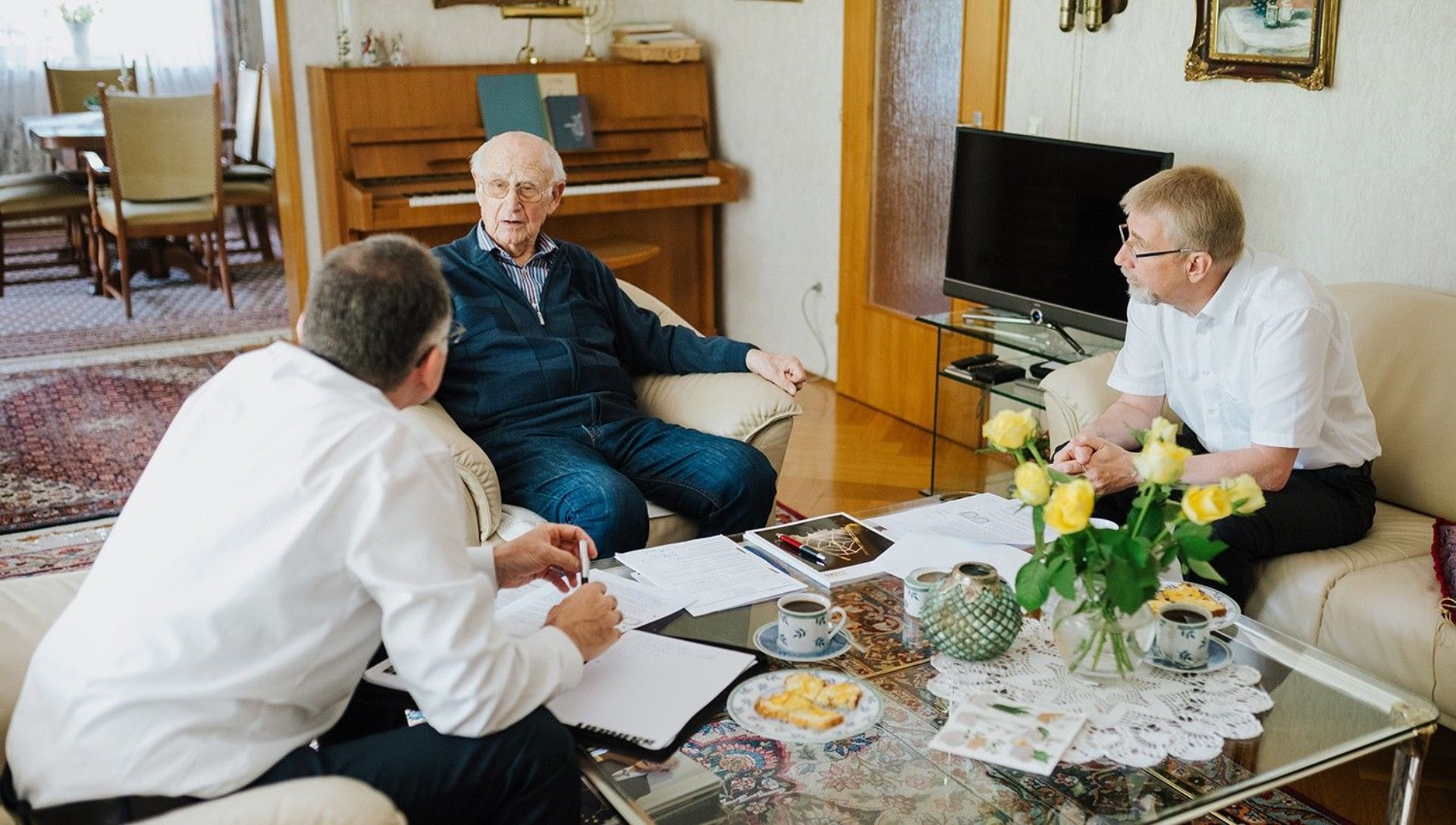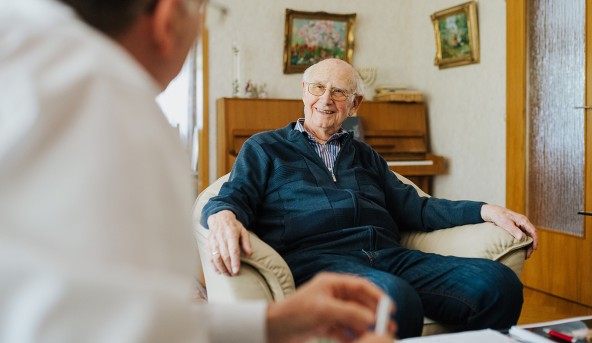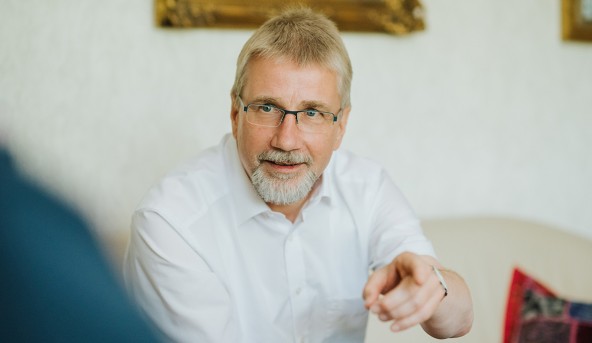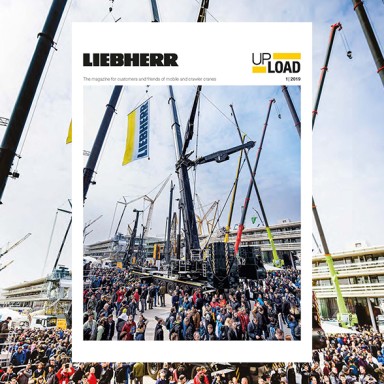
7 minutes | magazine 01/2019
Technical progress and entrepreneurial continuity the recipe for success
In the 50 years of the company’s history, Liebherr in Ehingen has only had two Technical Directors. This is an example of entrepreneurial continuity – a feature to which Liebherr has always attached a great deal of value. It was a special honour for us to be able to talk to Rudolf Becker, who was responsible for design between 1971 and 1994, and his successor Dr Ulrich Hamme about the development of Liebherr mobile and crawler cranes.
50 years, two Technical Directors: A review and outlook
Mr Becker, what experience did you have in the mobile crane industry when you started at Liebherr in Ehingen in 1971?
Rudolf Becker: I came from Demag in Düsseldorf, where I had been Senior Department Manager and Authorised Signatory for the Product Development Department for seven years. Prior to that I had worked for Gottwald for eight years as Group Manager in the Design Department. Both these companies started to develop and build cranes suitable for driving on public roads in around 1965. Demag also started designing crawler cranes with lifting capacities of up to 80 tonnes. If Dr Hans Liebherr had not employed me personally, I would not have come to Liebherr.
How did you assess the state of the art of Liebherr mobile cranes at the time?
Rudolf Becker: In Ehingen we initially built mobile cranes with telescopic and lattice booms, which previously had been manufactured by Liebherr in Biberach. The state of the art at the time, however, was still struggling from a lack of experience and market knowledge. Moreover, there was no acceptance of them on the market. However, there was enough courage and strength of will to catch up as quickly as possible with the personal support of Dr Hans Liebherr. The hard work and willingness of the Swabian workforce soon led to success. One shining example was that as early as 1971, a major order from Russia was completed for 50 telescopic cranes, which had to be operational in temperatures as low as -40°C.
We talked to customers and to crane operators. Where else should we get the information?
What were the primary objectives for product development at the time? And how did you achieve them?
Rudolf Becker: It quickly became clear that we have to create advantages over our competitors. At the time I often had indepth exchanges with my fellow director Friedrich Bär, who was responsible for Sales, discussing what we had to do not only to catch up but to get ahead. We also held these discussions with experienced crane customers, and with crane operators. They gave us some very useful ideas.
We decided on the following objectives which we achieved through sheer determination. The mobile cranes at the time were not licensed for motorway driving as they were unable to travel above 60 km/h. Since the rear axles had no suspension to help the crane’s stability, their speed was restricted to 60 km/h. To counter this, we decided to build suspension systems with swing arm bearings which would enable our cranes to be licensed for motorway driving at 80 km/h. That gave us a massive lead over our competitors.
There was increasing demand for improved all-terrain features on construction sites. We therefore designed the LTM series cranes with the larger wheels and tyres with better grip. The hydro-pneumatic suspension also achieved significant improvements. The electromagnetichydrostatic control system delivered extremely sensitive control for the cranes’ drive systems, particularly for hoisting and slewing movements.

Liebherr then became the market leader. What were the technical milestones in your opinion that made us the leading crane manufacturer?
Rudolf Becker: In structural steel terms, the use of high tensile fine grained steel types with yield points of up to 960 N / mm² was required to achieve a significant weight reduction. However, these materials were not licensed. Therefore, as Chairman of the “Standards Department for Mobile Cranes at the VDMA”, I worked with the Technical University of Darmstadt to look at carrying out notch impact tests on welded steel types to obtain approval as a standard using the test results.
The development of the patented oval cross-section form of the telescopic boom tubes was another milestone as they made it possible to use the maximum stresses without exceeding the buckling limits. Since this meant that buckling plates were no longer required, we were able to make the internal telescope sections wider. The larger boom crosssection increased lifting capacity and also meant we could make telescopic booms longer.
For lattice boom cranes on crawlers or wheels, the counter jib, the derrick system with suspended ballast, was an early introduction. That resulted in significant increases in lifting capacity. Later, we managed the same thing on telescopic cranes by using guying systems for the boom.
Did everything always go to plan?
Rudolf Becker: Of course not. Everything is always easier in hindsight. I can remember the case of an LG 1180 for loading transformers at a port in Iran. With a derrick system and 250 tonnes of suspended ballast, it was able to hoist 350 tonnes. The derrick was secured at the rear to the slewing platform. When we completed the first test hoists, the slewing platform bent significantly. That meant we had no choice but to reinforce the slewing platform.

Dr Hamme, you arrived at Liebherr in Ehingen in mid-1994 as Technical Director and took over responsibilityfor the “Design and Development” Department afteran induction period of just three months. Your professional background was in structural steel and statics and you also had experience as a managing engineer in plant construction. How did you assess our technology and our position against our competitors at that time?
Dr Ulrich Hamme: I found that the company had a solid technical foundation and a committed, motivated workforce. We were in the middle of switching to computer-aided design (CAD), first in 2-D and then later in 3-D. But it was also a difficult time because the mobile crane market had collapsed. We even discussed reducing the workforce, but fortunately it never came to that. Things quickly improved again in Ehingen. Our market share in AT cranes was around 30 percent at the time. That meant that we had potential to improve our position on the market. We managed to do that gradually over the following years to find ourselves in our current situation.
What was your focal point in terms of product development?
Dr Ulrich Hamme: We built fantastic cranes in the past, but sometimes we only did so in very small volumes. So our focus had to be on serial production. That required more standardisation and a clear structuring of our product range. Improving the performance of products is always an objective for designers, but we were also interested in improving flexibility – both for hoisting loads and for driving the machines on the road. Since our share of exports continued to grow, we also identified the need for universal cranes which could be used all over the world. That relates to almost every lifting capacity class and that trend continues today. And there is another very important point – safety has always been and continues to be our absolute priority.
We can continue to meet the challenges through high technical flexibility and entrepreneurial continuity.
What other points were important for you in the development process?
Dr Ulrich Hamme: As Rudolf Becker has already said, getting close to customers was an important key to our success at the time. The same can be said of the current situation. Close communication with customers and markets by sales and product management staff, and also direct lines of communication with the design team, is essential.
Another important point is to ensure that a Liebherr crane is a good, safe place to work for the crane operator. He should feel at home in the cab. And even though it sounds like a marketing slogan, high quality, availability and value retention have always been important to me. And the green credentials complex must also be included in the design and production processes and, indeed, the whole of the crane’s service life.
What do you think are the main technical milestones?
Dr Ulrich Hamme: Rudolf Becker has already mentioned the development of the oval boom section. At the same time, the TELEMATIK single-cylinder system made it possible to produce longer multi-section booms. The combination of both these innovations in telescopic booms as from 1996 saw lifting capacity values increase enormously. In 1997 we launched data bus technology for the first time on the LTM 1030 / 2. This led to completely new way of controlling the crane, from the diesel engine to the hoist limit switch, through digitalisation. The diagnostic features were also extended.
Other milestones included crane models that set new records, of course. The first 100 metre telescopic boom on the LTM 11200-9.1. The most powerful conventional crawler crane in the world in the form of the LR 13000. Its hook height is a world record at 245 metres.
But even more important than records is what supports our customers in their everyday work. If we were to ask them about milestones, VarioBase® would be one of the most popular answers. I’m absolutely certain of it because it was a really pioneering development delivering greater safety, flexibility and even better performance.
I also believe that the main criterion behind our success is the continuous expansion of our product range to make us a complete supplier. Crawler cranes were always the second string to our bow and recently we have returned to become a member of the group of rough-terrain crane manufacturers.

Editor’s note: It was very refreshing to meet eminent crane authority, Rudolf Becker, who is now 90 years old, in a relaxed private atmosphere and to enjoy his humour and clarity of thought. And the plaited bread loaf with butter and jam provided by his wife Christel was delicious!
Mr Becker, have you kept up with developments in the mobile and crawler crane industry during your retirement?
Rudolf Becker: Yes, the bug never leaves you. I have often driven around the factory site and looked at the new crane models. It is all very impressive.
Dr Hamme, what challenges do you currently see facing us in the industry?
Dr Ulrich Hamme: The world is becoming more heterogeneous, the requirements for mobile cranes and so on are drifting apart. Bringing them back together again will be a major challenge in the future. Automation, digitalisation, networking, autonomy, electrification, alternative drive types, climate change and environmental protection – these are the modern drivers and, of course, they are also important topics for us.
However, we must separate the essential things from the non-essential ones and continue to ask questions about whether things are sensible and feasible so that we don’t spread ourselves too thin. The idea is to do the right thing at the right time! Of course, we have to stay on the ball with all these topics to enable us to steer the company in the right direction.
It is important that we never forget the basic functions of a mobile crane – mobility and lifting capacity. In other words we have to “do one thing and not forget the other”. As in the past, we will be able to meet the challenges of the future through high technical flexibility and entrepreneurial continuity.
This article was published in the UpLoad magazine 01 | 2019.



